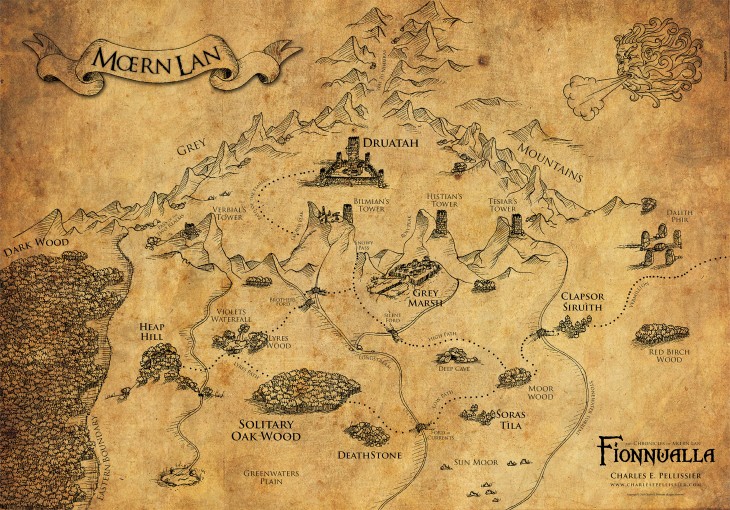As you guys may have read from the site, I am fond of languages, I’d rather say maniacally, sickly fond of languages; and as you may have seen in the book, if you’ve read it, I’ve used words and names that may appear unpronounceable… So, I would better provide the right tools to read them! 🙂
After having studied and loved some Romance, Germanic and Slavic languages, I felt the necessity to create a tongue myself; so I developed a grammar and a vocabulary.
In the first book of “The Chronicles of Mœrn Lan”, you can find the first language I created: the Arboreal Tongue or simply Njalo, generally spoken by ethereal creatures of the Kingdom of Vesper, over Dark Wood… And today we are focusing on it :). Later on, with the second book of the series, I’m going to reveal the other tongues.
 The Arboreal Tongue is composed of 12 vowels and 22 consonants. That’s a lot of letters! Well, it is not over, because many of these letters, if combined with others, can reproduce similar sounds with different length. Let’s see some vowels; the first sign should be read as a short sound, the second as a long one.
The Arboreal Tongue is composed of 12 vowels and 22 consonants. That’s a lot of letters! Well, it is not over, because many of these letters, if combined with others, can reproduce similar sounds with different length. Let’s see some vowels; the first sign should be read as a short sound, the second as a long one.
A, AA: intermediate sound between A and O, like “bar, father”.
À, Æ: intermediate sound between A and E, like “met, berry”.
E, AI: acute E, like in French “étoile”.
I, J: simple I, like “see, me”.
Ì: intermediate sound between I and E, “hit, bit”.
O, AU: closed O, like “more, shore”.
Ò: corresponds to A sound, like “but, cup”.
U, OU: simple U, like “put, could”.
Y, Ÿ: classic French U or German Ü.
Ɇ: classic French E, like “arbre, coudre”.
Œ: sounds like “burn, bird”.
Let’s not forget the consonants:
B: like “bar”.
C: union of T and S.
Ȼ: wet sound like “choose”.
D: like “doubt”.
F, PH: like “father”. PH sounds like a double F.
G: hard sound if at the beginning or in the middle of the word, like “get”; soft exhale if at the end.
H: simple exhale. If coupled with other consonants, it reproduces different sounds. KH, GH have hard exhale; CH has soft exhale.
K: like “key”.
L: like “lizard”.
M: like “mother”.
N: like “nurse”.
P: like “parrot”.
Q: the same as K if at the beginning or in the middle of a word; soft exhale if at the end.
R: like Scottish R.
S: like “sound”.
Ś: like “lizard”.
Ŝ: like “shore”.
T: like “tundra”.
Ⱦ: like “think”.
V, BB: like “valley”. The double B sounds like a double V.
Z: like “casual”.
Ź: like “judge”.
This stream of letters is not enough to read Njalo words; let’s have a look to the accent, then. Almost all Njalo words are proparoxytone; so, with not expressly accented words, consider the following table. Words with:
1-2-3 syllables → the accent falls on the first. Ex: Gorchlach; rha; lihfal.
4 syllables → the accent falls on the second. Ex: gylmesgirim.
5 syllables → the accent falls on the third. Ex: Navilemnia.
In addition to the length of the words, you have to take into account the vowels composing the words or the letters called leader, horseman and infantryman.
The leader letter: J. It conveys the accent on itself, whatever the length of the word is. Ex: lihfjn and not lihfjn.
The horseman letters: Æ and Œ. They convey the accent on themselves, whatever the length of the word is, but only if there’s no leader. In case of two horsemen, Æ wins.
The infantryman letters: Ÿ, AA, AI, AU, OU. They convey the accent on themselves, whatever the length of the word is, but only if there’s no leader, nor horsemen. In case of many infantrymen, the one composed of less letters wins or of the highest letters (AA> OU).
😀 😀 Hooray! Now, after this long and exhausting explanation, you should be able to read words like Mœrn Lan, Grÿljr, Ŝoras Tìla, Meraiźi and so on :).







